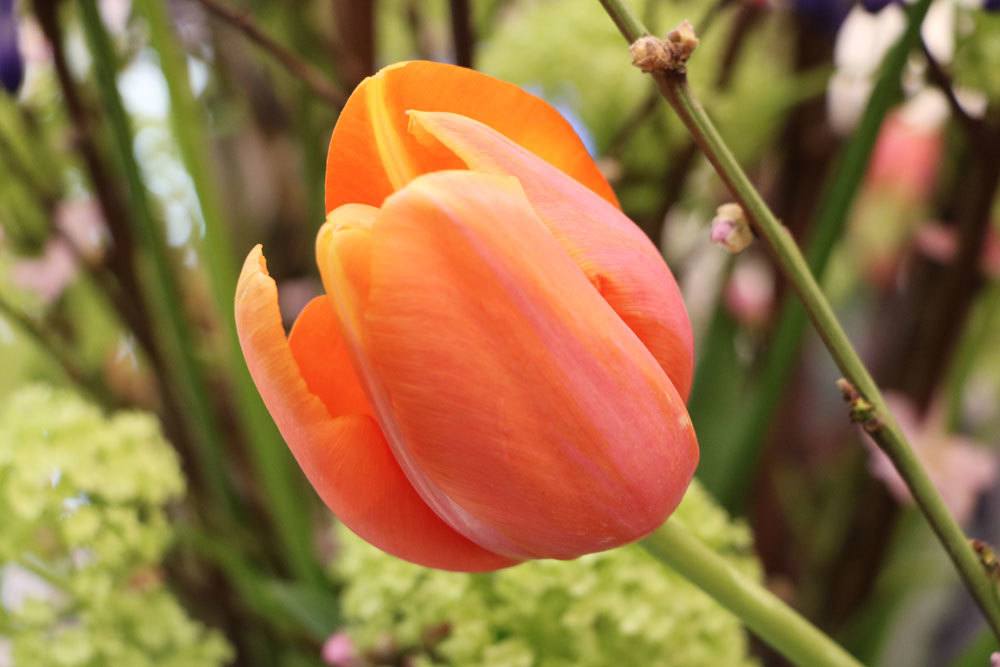At the end of their flowering period tulips cause headaches for the amateur gardener. The question rightly arises: is it permissible to cut off faded tulips so easily? If you rush to the scissors, you stop a vital process that already ensures the next bloom magic. This guide explains in detail how to expertly perform care after flowering. What are the options for the proper handling of tulip bulbs withered, you can learn here.

Contents
Why cut faded tulips?
That is why cut faded tulips.
Tulips thrive as perennial plants whose flower stalks and leaves rise from bulbs as an organ of survival. In each tulip bulb rests the life force for many years in magnificent flowering beauty. If it were not for the plant’s desire to reproduce itself in as large a number as possible with the help of seeds. To produce the seeds after flowering, a tulip invests a lot of energy, which is then lacking for the next flowering season.
At this point, the plans of the gardener and his tulip diverge. In the ornamental garden, the focus is on a lavish tulip bloom rather than propagation by self-seeding. Thus, pruning wilted tulips takes on a key function within expert care.
Cut off wilted tulips
Cut wilted tulips in stages
The ideal pruning of a tulip has two goals. On the one hand, the undesirable, energy-sapping seed growth is prevented, and on the other hand, the remaining nutrients of the leaves should not be lost. Therefore, experts advocate cutting a faded tulip in 2 stages.
Here’s how to do it right:
- cut the main stem in such a way that the withered flower is removed
- leave all green parts of the plant in the bed at this stage
- do not cut leaves and stems close to the ground until they are completely yellowed
- This procedure ensures that the valuable nutrients are transferred to the tulip bulb. From this, reserves are formed, from which the next spring’s flowering will benefit. This reallocation of nutrients takes a long time and should not be interrupted prematurely. Therefore, a lawn should not be mowed for the first time until the foliage is completely absorbed and dead.
Late cutting is risk
Tulip leaves cut too late pose risks.
While cutting too early destroys important nutrient reserves, cutting too late risks rot, disease and pest infestation. You can tell the perfect time to remove tulip leaves that have retracted by these symptoms.
Best time to remove the tulip leaves:
the yellowed foliage no longer has green spots
the leaves, which were firm during the flowering period, are visibly softening
the tulip foliage gradually slopes to the ground
Please do not delay pruning until the leaves can be plucked out. When a tulip bulb pushes off its above-ground plant parts, the process of storing nutrients is complete. The resulting softened leaves magically attract pests and pathogens.
Care after flowering
Instructions for perfect care after flowering
At the end of the flowering period, the growth phase of a tulip is far from over. Under the ground, preparations for the next season are now in full swing. By cutting a main stem to prevent the growth of capsule fruits, the tulip bulb is now focused around its continuation. With the following care after flowering, you support the busy spring messenger in its efforts.
fertilize from the middle/end of May with sieved compost, guano granules or horn shavings
apply a liquid fertilizer in the flower box and tub
until the retracted leaves are cut, continue watering when the soil has dried out
Once you have cut all plant parts close to the ground, the natural rainfall will cover the low water needs during the summer.
Store tulip bulbs
Properly over-summer tulip bulbs
A tulip bulb tends to bore steadily deeper into the soil until it disappears never to be seen again. To counteract this process, we recommend returning to a traditional way of oversummering a tulip bulb. In this case, the bulbs do not linger in the ground, but are dug up and stored until autumn.
in May/June gradually cut off all the withered and the retracted leaves.
then lift each tulip bulb out of the ground with a digging fork
cut off the dead roots with sharp, disinfected scissors
clean the bulbs with a brush and do not wash them with water.
The clean tulip bulbs spend in the cool, dark cellar and beat them in sphagnum, sand or newspaper. Damaged specimens or those covered with brown spots, please sort out, because here there is no prospect of an unscathed oversummer. Until the planting season begins in the fall, check the bulbs regularly for diseases and pests.
Gloves for protection
Gloves protect against poisonous tulipanin.
All species of tulips contain the toxin tulipanin. This toxin exerts the following harmful effects on human physiology, both internally and externally.
Skin contact
Irritation, eczema, inflammation as well as torn skin (tulip dermatitis)
Consumption of several onions
stomach cramps, vomiting, circulatory disturbances up to respiratory arrest
Since the care after flowering is connected with frequent contact with the tulipanin-containing sap, we recommend wearing gloves and long-sleeved clothing. Furthermore, it should be remembered that there is often confusion between tulip and edible bulbs.
If you store the bulbs in the cellar over the summer, please make sure that the two types of bulbs are stored separately. Since the toxin also has a harmful effect on animals, do not dispose of the cuttings and sorted tulip bulbs on the compost, cattle or horse pastures.









